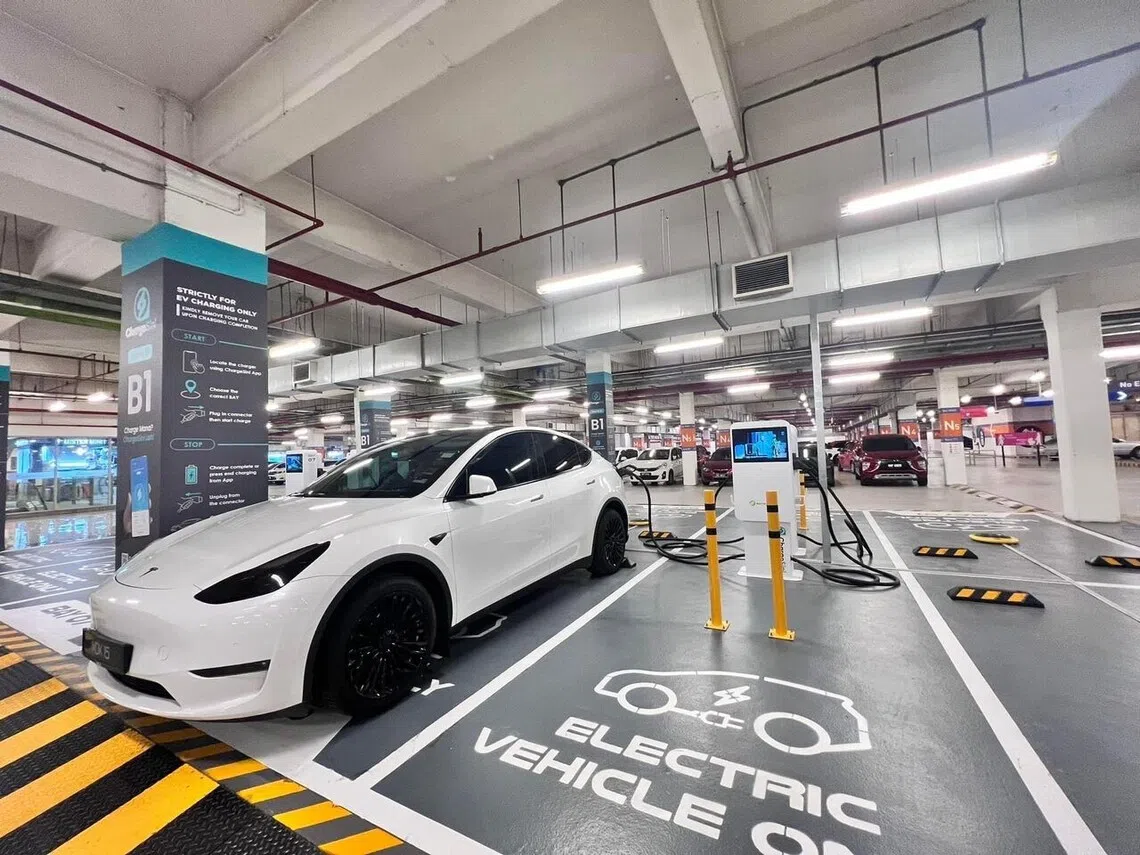Affordable EVs have landed in Malaysia, but the country still trails Asean peers
Analysts do not expect it to catch up in the short term

[KUALA LUMPUR] Proton’s first electric vehicle (EV) assembly plant, officially launched in September, is expected to boost the adoption of EVs in Malaysia as the company rolls out more affordable models.
The plant is Malaysia’s first dedicated EV assembly facility, and marks a major milestone for the nation and Proton. It has already begun production of the Proton e.MAS 7, Proton’s first fully electric model.
It will also produce the Proton e.MAS 5, dubbed Malaysia’s “first affordable EV for the rakyat”. The model’s public launch has drawn keen interest, drawing over a million online viewers when it was unveiled during a livestream on Oct 2, and garnering more than 5,000 bookings within three weeks of its debut.
The mass-market EV hatchback is priced starting at RM56,800 (S$17,672).

Roopa Malhotra, head of customer and digital for Asia Pacific at Zurich Insurance, said Proton’s entry into EV manufacturing will boost competition, making electric cars more affordable and accessible.
The e.MAS 7’s launch last December and the upcoming budget-friendly e.MAS 5 have already prompted other brands to rethink pricing, widening options for consumers.
As Proton ramps up production at the new plant, other brands including BYD, Zeekr, Volvo, and Volkswagen have committed to local assembly, supported by incentives extended through 2027.
“Competition matters from an insurance perspective as a bigger, more diverse EV market creates a larger risk pool, helping to stabilise coverage and reduce volatility,” said Malhotra.

But despite consumer enthusiasm, Malaysia’s EV market still lags that of regional peers. Analysts do not expect the market to catch up in the short term.
In the first eight months of 2025, 23,396 EVs were registered in Malaysia – a 63 per cent year-on-year increase. Yet, EVs still accounted for just 4.2 per cent of total vehicle sales during that period.
In neighbouring Thailand, EVs make up 20 per cent of new car sales. In Singapore and Vietnam, the figure is 40 per cent.
Aritra Jana, partner at Kearney, estimates that EV adoption in Malaysia could reach 9.6 per cent by end-2025. However, that still leaves Malaysia far behind the regional curve.
The Malaysian government has pledged to make EVs 15 per cent of new car sales by 2030.
Yichao Zhang, partner at AlixPartners, observed that Malaysia’s market is at an early stage of adoption, dominated by early adopters rather than the mass market.
“We don’t expect it to catch up with regional peers in the short term,” he added.

Policy gaps
One key problem is that Malaysia’s current EV incentives – which include import and excise duty exemptions, sales tax waivers on locally assembled EVs, and individual income tax relief – primarily target consumers.
Experts argue that while the Malaysian government has in place the Green Investment Tax Allowance (GITA) as a major tax incentive scheme to encourage both companies and projects to invest in green technology and solutions, these policies fall short in accelerating crucial charging infrastructure development or bridging the cost gap with internal combustion engine (ICE) vehicles.

Kearney’s Jana pointed out that neighbouring countries have “taken more aggressive measures by providing capital grants, land subsidies, and low-cost utility connections, which help reduce the initial risks for charging point operators”.

Large-scale infrastructure funding is lacking in Malaysia, especially when compared to regional peers such as Thailand and Indonesia, where green loans backed by the Asian Development Bank provide vital support, he added.
James Goh, founder and chief executive officer of ChargeSini, Malaysia’s largest charging-point operator, told The Business Times that ChargeSini has grown rapidly since its 2022 founding, operating 1,200 charging bays across Malaysia, up from 930 in May.
But expansion has slowed. “We are awaiting bank approvals for financing,” he said. “Even with loans, each roll-out must be planned carefully.”

Installing an alternating-current charger – the cheaper but slower option – costs around RM25,000 to RM30,000 per bay, while faster direct-current units, which deliver 60 to 80 kilowatts of power, can run up to RM180,000 each.
“Banks hesitate to provide large amounts of financing because the industry lacks utilisation data,” said Goh. “They will still lend, but in smaller amounts so they can monitor the industry and utilisation growth.”
Discover how the EV journey is unfolding across South-east Asia in our interactive here.
Decoding Asia newsletter: your guide to navigating Asia in a new global order. Sign up here to get Decoding Asia newsletter. Delivered to your inbox. Free.
Copyright SPH Media. All rights reserved.





